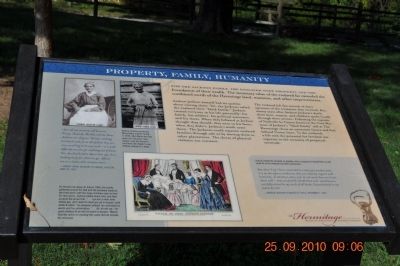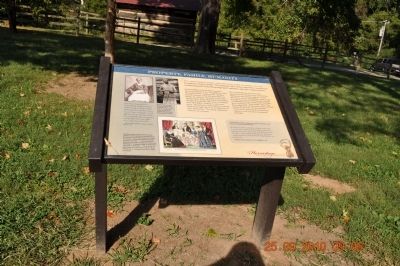Hermitage in Davidson County, Tennessee — The American South (East South Central)
Property, Family, Humanity
Andrew Jackson himself had no qualms about owning slaves. Yet, the Jacksons called the enslaved their “black family.” Jackson treated everyone in his life paternally—his family, his soldiers, his political associates, and his slaves. When they behaved as Jackson thought they should, they were in his favor; when they didn’t, Jackson’s wrath came down. The Jacksons could separate enslaved families through sale or by moving them to other plantations. The threat of physical violence was constant.
The enslaved left few records of their opinions of the treatment they received. But, twenty years after Andrew Jackson’s death, these men, women, and children spoke loudly through their actions. Following the capture of Nashville by Union forces in the Civil War, most of Jackson’s “black family” still at The Hermitage chose an uncertain future and fled behind Union lines. To the enslaved, a life with the potential for freedom was superior to the certainty of perpetual servitude.
Topics and series. This historical marker is listed in these topic lists: African Americans • Agriculture • Industry & Commerce • Settlements & Settlers. In addition, it is included in the Former U.S. Presidents: #07 Andrew Jackson series list.
Location. 36° 12.987′ N, 86° 36.764′ W. Marker is in Hermitage, Tennessee, in Davidson County. Marker can be reached from Rachels Lane, 0.3 miles east of Hermitage Road. This marker is located on the path several feet from the Spring House. On the left side. Touch for map. Marker is at or near this postal address: 4580 Rachels Lane, Hermitage TN 37076, United States of America. Touch for directions.
Other nearby markers. At least 8 other markers are within walking distance of this marker. The Hunter’s Hill Farm Building (a few steps from this marker); The Springhouse (within shouting distance of this marker); Field Quarter Trail (within shouting distance of this marker); Cabin-by-the-Spring (within shouting distance of this marker); Alfred’s Cabin (about 300 feet away, measured in a direct line); The Work Yard (about 400 feet away); The First Hermitage (about 400 feet away); The Triplex (about 400 feet away). Touch for a list and map of all markers in Hermitage.
Also see . . . The Hermitage, The Home of President Andrew Jackson. (Submitted on February 10, 2012, by Bernard Fisher of Richmond, Virginia.)
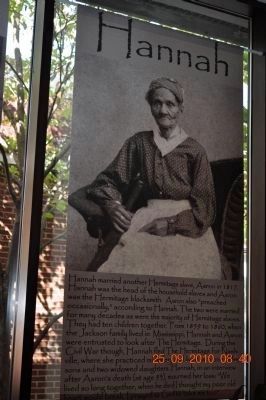
Photographed By Sandra Hughes, September 25, 2010
3. Hannah Jackson c1880 (pic in museum)
I fear all our servants will leave us. Nancy, Hannah, Martha, and her three children are all gone. We have nothing but black looks from all of them they are very unwilling to do any work – it is with difficulty we can get anything out of them. Drs. Joe Smith left a day or two ago, he is looking daily for others to go. Affairs are in a deplorable situation here…
-Sarah Yorke Jackson to Samuel Jackson, June 22, 1863
[Text in photo] Hannah married another Hermitage slave, Aaron in 1817. Hannah was the head of the household slaves and Aaron was the Hermitage blacksmith. Aaron also “preached occasionally,” according to Hannah. The two were married for many decades as were the majority of Hermitage slaves. They had ten children together. From 1859 to 1860, when the Jackson family lived in Mississippi, Hannah and Aaron were entrusted to look after The Hermitage. During the Civil War though, Hannah fled The Hermitage for Nashville, where she practiced midwifery and lived with one of her sons and two widowed daughters. Hannah, in an interview after Aaron’s death (age 93), mourned her loss: “We lived so long together, when he died I thought my poor old heart would break. I prayed God to take me too”.
-Sarah Yorke Jackson to Samuel Jackson, June 22, 1863
[Text in photo] Hannah married another Hermitage slave, Aaron in 1817. Hannah was the head of the household slaves and Aaron was the Hermitage blacksmith. Aaron also “preached occasionally,” according to Hannah. The two were married for many decades as were the majority of Hermitage slaves. They had ten children together. From 1859 to 1860, when the Jackson family lived in Mississippi, Hannah and Aaron were entrusted to look after The Hermitage. During the Civil War though, Hannah fled The Hermitage for Nashville, where she practiced midwifery and lived with one of her sons and two widowed daughters. Hannah, in an interview after Aaron’s death (age 93), mourned her loss: “We lived so long together, when he died I thought my poor old heart would break. I prayed God to take me too”.
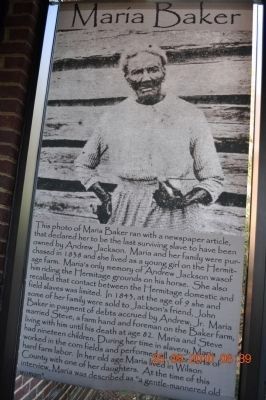
Photographed By Sandra Hughes, September 25, 2010
4. Maria Baker c1921 (pic in museum)
Andrew Jackson purchased Maria Baker and her family in 1838, when Maria was four years old. Five years later, Jackson sold the family to his friend John Baker to pay Andrew Jackson Jr.’s debts.
[Text in photo] This photo of Maria Baker ran with a newspaper article, that declared her to be the last surviving slave to have been owned by Andrew Jackson. Maria and her family were purchased in 1838 and she lived as a young girl on the Hermitage farm. Maria’s only memory of Andrew Jackson was of his riding the Hermitage grounds on his horse. She also recalled that contact between the Hermitage domestic and field slaves was limited. In 1843, at the age of 9 she and some of her family were sold to Jackson’s friend, John Baker in payment of some debts accrued by Andrew, Jr. Maria married Steve, a farm hand and foreman on the Baker farm, living with him until his death at age 82. Maria and Steve had nineteen children. During her time in slavery, Maria worked in the corn fields and performed all other sorts of hard farm labor. In her old age Maria lived in Wilson County with one of her daughters. At the time of this interview, Maria was described as “ a ?”
[Text in photo] This photo of Maria Baker ran with a newspaper article, that declared her to be the last surviving slave to have been owned by Andrew Jackson. Maria and her family were purchased in 1838 and she lived as a young girl on the Hermitage farm. Maria’s only memory of Andrew Jackson was of his riding the Hermitage grounds on his horse. She also recalled that contact between the Hermitage domestic and field slaves was limited. In 1843, at the age of 9 she and some of her family were sold to Jackson’s friend, John Baker in payment of some debts accrued by Andrew, Jr. Maria married Steve, a farm hand and foreman on the Baker farm, living with him until his death at age 82. Maria and Steve had nineteen children. During her time in slavery, Maria worked in the corn fields and performed all other sorts of hard farm labor. In her old age Maria lived in Wilson County with one of her daughters. At the time of this interview, Maria was described as “ a ?”
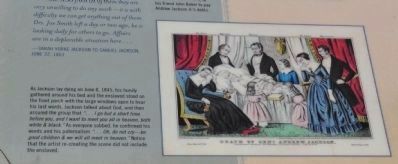
Photographed By Sandra Hughes, September 25, 2010
5. Death of Gen’l Andrew Jackson
As Jackson lay dying on June 8, 1845, his family gathered around his bed and the enslaved stood on the front porch with the large windows opened to hear his last words. Jackson talked about God, and then assured the group that ”…I go but a short time before you, and I want to meet you all in heaven, both white & black.” As everyone sobbed, he confirmed his words and his paternalism ”…Oh, do not cry-be good children & we will all meet in heaven.” Notice that the artist re-recreating the scene did not include the enslaved.
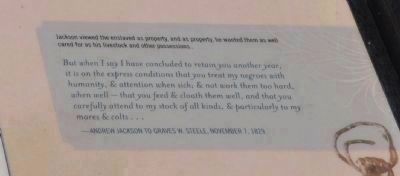
Photographed By Sandra Hughes, September 25, 2010
6. Jackson viewed the enslaved as property...
Jackson viewed the enslaved as property, and as property, he wanted them as well cared for as his livestock and possessions.
But when I say I have concluded to retain you another year, it is on the express condition that you treat my negroes with humanity, & attention when sick; & not work them too hard, when well- that you feed & cloath then well, and that you carefully attend to my stock of all kinds, & particularity to my mares & colts…
-Andrew Jackson to Graves W. Steele, November 7, 1829
But when I say I have concluded to retain you another year, it is on the express condition that you treat my negroes with humanity, & attention when sick; & not work them too hard, when well- that you feed & cloath then well, and that you carefully attend to my stock of all kinds, & particularity to my mares & colts…
-Andrew Jackson to Graves W. Steele, November 7, 1829
Credits. This page was last revised on February 7, 2023. It was originally submitted on February 9, 2012, by Sandra Hughes Tidwell of Killen, Alabama, USA. This page has been viewed 586 times since then and 14 times this year. Photos: 1, 2, 3, 4, 5, 6. submitted on February 9, 2012, by Sandra Hughes Tidwell of Killen, Alabama, USA. • Bernard Fisher was the editor who published this page.
